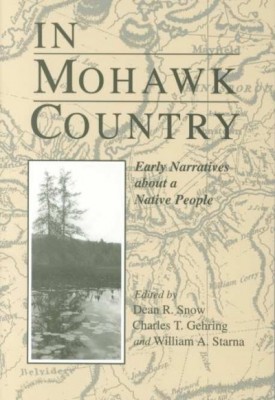| In Mohawk Country: Early Narratives of a Native People Contributor(s): Snow, Dean (Editor), Gehring, Charles (Editor), Starna, William (Editor) |
|
 |
ISBN: 0815604106 ISBN-13: 9780815604105 Publisher: Syracuse University Press OUR PRICE: $26.96 Product Type: Paperback - Other Formats Published: December 1996 |
| Additional Information |
| BISAC Categories: - History | United States - State & Local - Middle Atlantic (dc, De, Md, Nj, Ny, Pa) - Social Science | Ethnic Studies - Native American Studies - History | Native American |
| Dewey: 974.760 |
| LCCN: 96-43348 |
| Series: Iroquois and Their Neighbors |
| Physical Information: 0.93" H x 6.21" W x 9.3" (1.35 lbs) 432 pages |
| Themes: - Ethnic Orientation - Native American |
| Descriptions, Reviews, Etc. |
| Publisher Description: For centuries the history of the Mohawk Valley has been shaped by the complex relationships among the valley's native inhabitants, the Mohawk Indians, and its colonists, starting with the Dutch. In Mohawk Country collects for the first time the principal documentary narratives that reveal the full scope of this Mohawk-settler interaction. Some of the sources have never before been translated into English, and several have not been previously published. Of those works that had been published, nearly all are out of print. The Mohawk location near Albany, New York put them at the center of transactions between the Iroquois and European colonists. (The Mohawk were one of the constituent nations within the League of the Iroquois.) These narratives-written by Dutch merchants, French Jesuit missionaries, English soldiers, romantic European travelers, and other literate observers-provide often biased but always fascinating accounts of the Mohawk and their valley. The reader is treated to over two centuries of history, starting with the arrival of the Dutch in the early seventeenth century to the planning of the Erie Canal in the early nineteenth century. These records bring to life the rapid changes experienced by both the Mohawk and their European neighbors. Wars, catastrophic epidemics, and the diplomacy of nearly two centuries are all well represented in this volume. Fascinating cultural differences are also unearthed: the French, for example, dealt with the Mohawk much differently than the Dutch or the English. Just as importantly, these writings reveal--from the unique perspectives of the observer--the Mohawk's struggle to retain their culture in the midst of evolvingpolitical, social, and physical environments. |